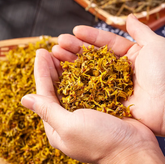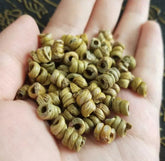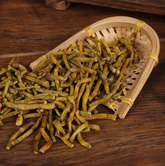Poria cocos - One of the Nine Noble Herbs
Poria cocos belongs to the family Polyporaceae. It is a saprophytic fungus that grows on the roots of certain trees, especially pine trees. Usually, it forms large, irregularly shaped masses or nodules. Its exterior is often rough and has a hard, woody texture in some cases. The color can range from light brown to dark brown. When cut open, the inner part is white or creamy-white, with a fine, granular texture that resembles marble.
In traditional Chinese medicine, Poria cocos has been highly valued for thousands of years. It has a bland taste and a neutral nature, which means it is relatively mild and suitable for a wide range of people. It acts on the heart, spleen, lung, and kidney meridians.
It is renowned for its functions of promoting diuresis to reduce edema, invigorating the spleen and stomach, and calming the mind. It is often used to treat conditions such as edema due to spleen deficiency, poor appetite, loose stools caused by weak spleen function, and insomnia or restlessness due to a disordered state of the mind.
Poria cocos can be used in various forms. For instance, it can be made into decoctions by boiling it with other herbs. Also, it is commonly processed into powder and added to porridge or other food to make it easier to consume while still maintaining its medicinal effects.
Poria cocos has a deep-rooted presence in Chinese culture. It has been frequently mentioned in ancient medical texts and traditional folk medicine knowledge. In ancient times, it was regarded as a precious herbal medicine that could help people maintain good health and treat various ailments. Moreover, it has also appeared in some traditional stories and folklores, symbolizing health and vitality.
In modern scientific research, studies have shown that Poria cocos contains a variety of bioactive compounds, including polysaccharides, triterpenes, and proteins. These components have demonstrated certain pharmacological effects. For example, the polysaccharides have been found to have immunomodulatory functions, which can help enhance the body's immune system. The triterpenes may have anti-inflammatory and antioxidant properties, which are beneficial for dealing with some chronic diseases and maintaining the body's health.
Overall, Poria cocos is not only an important part of traditional Chinese medicine but also a subject of great interest in modern medical research, with the potential to contribute to human health in multiple ways.
- Choosing a selection results in a full page refresh.







